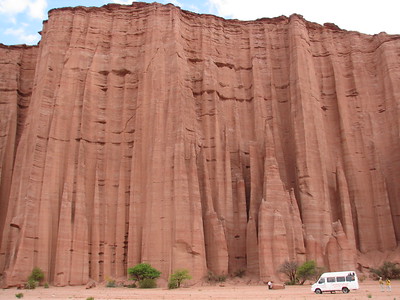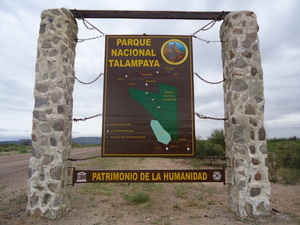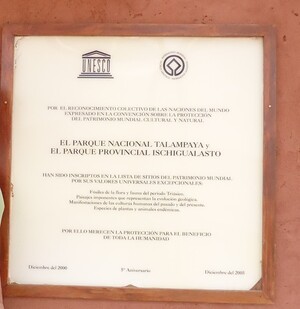Ischigualasto / Talampaya

The Ischigualasto / Talampaya Natural Parks protect geological formations of the Triassic Period where the evolution of vertebrate life can be witnessed.
These contiguous parks are rich in diversity of both plant and vertebrate fossils of the entire Triassic Period, when dinosaurs and mammals came into existence. Some of the oldest known dinosaur remains were found in this location, which makes it one of the most important palaeontological sites in the world.
Community Perspective: The sites are best reached from the town of La Rioja, although they still are 200km away. Count on a very full day of travel to visit them both. Michael has described how to reach Talampaya on public transport; for Ischigualasto you need a car. At both locations guided tours are conducted in an orderly fashion, but ”you need to really love rock formations and hard to see petroglyphs to get much out of it”. Read Frederic's tale to understand how weather-dependent a visit is.

Map of Ischigualasto / Talampaya
Community Reviews
Frédéric M

This review will be one of disappointments and cautionary tales. I (almost) visited Ischigualasto and Talampaya parks in March 2023. I have been there and seen some elements of it, which by my standards is enough to count as a visit. However, my rating is definitely to be taken with a grain of salt.
I visited these parks with a tour operator in La Rioja (I can't remember for sure which one, but I think it was Corona del Inca). Since they didn't offer the Saturday tour I had targeted, I shifted my visit to Sunday. In doing so, I stayed an extra day in Cordoba (which has much more to offer than La Rioja) and spent one less in Salta. The tour operator picked me up at the hotel under a beautiful sun and we left for the parks with two other Argentinian tourists.
But it got ruined on the way, as it started to rain. Although the rain was just a light drizzle in Ischigualasto, the tour was delayed and ultimately cancelled. The excursion involved traveling in personal cars across some dry streams, which could become dangerous rivers when it rains. While waiting at the visitor's center, I visited the excellent Museo de Ciencias Naturales de Ischigualasto, which had fossils, bones, and replicas of the main dinosaurs found in the park. Outside, there was a rather banal viewpoint of the park's landscape.
We then proceeded to Talampaya, hoping that the tours there were not cancelled. The road between the parks crosses a part of Talampaya and offers very beautiful sceneries. Although the tours were conducted in large vehicles belonging to the park, the morning rain had made some of the rivers dangerous to cross. Unlike Ischigualasto, the Talampaya Visitor Center offers few alternative (or waiting) attractions. A short trail, the Parque Triásico, allows us to see some rather faded dinosaur replicas. So we left Talampaya without visiting the incredible landscapes it contains.
Despite the disappointment, the tour operator offered an interesting alternative trip for the afternoon. We followed the Ruta 40 to the spectacular viewpoints of the Cuesta de Miranda and visited the Cristo del Portezuelo and the Cable Carril in Chilecito. The agency also offered to postpone the activity to the next day, but I was already in Salta, having taken a night bus the same evening. While the two Argentinians were able to see all the wonders of Ischigualasto and Talampaya the next day, I could not afford to lose any more days in the north. My advice to future visitors is to check the weather and be flexible in their itinerary for this part of Argentina. It is best to plan for extra days in case of unforeseen circumstances and cancellations.
Timonator

In my lonely planet travelbook and in this community I encountered various distinctive ways how to reach these remote natural parks. In the end I decided to go into the Province capital of La Rioja which is still about 2 hours or 200 km from the park entrances but by this the next big city in reach. It's a pleasant town in autumn with summer like weather every day- I can imagine that it gets too hot in real summer here. We checked out the information kiosk on the plaza and it was giving us some outdated prices of the Talampaya park. Information about Ischigualasto was hardly available as this park which is connecting to Talampaya park at the province border of La Rioja and San Juan is on the wrong side of the province border. It's even greyed out on the tourist maps like anything else outside the province. Argentinian tourist information counters really don't care about how their customers are thinking especially when it comes to provincial borders. Nevertheless they could give us contacts of travel agencies and rental car services which was helpful. As we wanted to visit both parks and it became clear that Ischigualasto which is commonly named Valle de la Luna (Moon Valley) is not reachable by public transport. The tourist office guy even said that not all buses from La Rioja to Villa Unión pass by Talampaya but that it could be that they take a more northern route nowadays. But again this could be true maybe only for some buses and it's best to check it out yourself in the terminal. As Els had been writing that visiting both parks would take at least 12 hours it also became clear that a rental car was not the solution as we would be way too tired during the actual visits if we had to drive around 500 km on this day additionally. So we went to the two tour agencies and fixed a trip as they nicely offer trips that combine both parks. In the end we got a private driver which was nice however also much more expensive than if we had found 2 more fellow travellers that would share the car and cost with us. We paid travel GIT 50.0000 ARS (price for 2. currently with blue dollar rate a bit more that 100 EUR). It would have been 36.000 ARS with two other visitors. VGP offered us 54.000 ARS and only 27.000 ARS if we were 4. However we had a better feeling with travel git. Both have offices close to the central plaza. In the oarks there are additional fees. We paid 5.000 ARS for the entry and tour in Ischigualasto and 7.000 ARS for the entry in Talampaya plus 20.000 ARS for the 4x4 Tour in the park. So quite an expensive day but all components of the WHS visited.
WE started in La Rioja at 06:30 a.m. and reached Ischigualasto visitor center at 08:40 a.m.. There is a nice museum with displays on the current flora and fauna and the dinosaur excavations. Also there is a bar and baños. At 09:30 a.m. the tour started which worked as a Caravan set-up, so each visitor car lined up and drove through the park. There was also a bus I guess for people without car. In the first car was the guide that made explainstions at each of the 5 stops as we had left the cars. Basically the drive is through an old lake that has dried out a long time ago. It did contain salt and fresh water, where the salt water was coming from the Pacific Ocean. Due to the errosion and the fact that this place was the last with water in the area many rock formations but also dinosaur fossils can be found here. You get to see sediment "balls" and slim rock towers during the ride. Of course humans have interpreted various objects into the formations which explains why they all have names. Additionally there is a small museum again with baños and bar that explains how palenthologists work in a movie and with a guide. The final stop is the "mushroom" which is in front of the impressive 250m Wall of red rock which forms the border of San Juan to La Rioja and by this the border to Talampaya National Park. I also found interesting that these famous rock formations sometimes break due to Wind and earthquakes. The "submarine" has lost a tower by this in 2015.
The Talampaya NP was another 40 minute drive away, however it was a very different experience to visit it. The 4x4 truck that took us into the center of the park stopped in front of another wall of red coloured rocks. In Ischigualasto everything is rather white whereas Talampaya is completely red- the sand and the rocks. In the first stop we saw some petroglyphs with guanacos. We didn't understand too much as we were the only non- fully Spanish speaking people however after asking we also got easier explainations at later stops. In Talampaya there are not so many fossils but it's more about the gigantic rocks and the valley between them that one drives through. The rocks easily reach 300m from the floor and are maximal steep. In the valley there is a microclimate as sometimes alao rainwater (mainly in summer) runs through. By this trees are growing and some animals like maras live here. The fruits of the carob were food ressource for the aboriginal people. Also the valley has a really nice echo effect. Afterwards agaib some significant rock formations like the monk are visited. Most impressive is the Cathedral though as it's a huge, red wall in front of you. In the last stop which is not taken by the minibusses one walks through the Shimpa valley which has a bit lower rocks to both sides and is more narrow. The guide demonstrated the diffrrent sediment layers here however it was not really a necessary stop for me. Also the two snack stops with wine, sparkling wine, soup and coffee were surprising but not really needed. After three hours we returned to the visitor center where we walked a small dinosaur trail, which is not super interesting and then we drove the two hours back to La Rioja.
I found intersting that there seems to be really a mixed opinion on the protection status of the parks. The guide in Ischigualasto said as a Provincial park we can take much better care of the area. And in Talampaya the guide was saying that if Talampaya was a proncial park then nothing would be really protected and only the NP status really protects an area. In addition it was interesting that the Ischigualasto area was traded in the 1960s from La Rioja to San Juan province in exchange for something else. It's all a bit strange.
I can recommand visiting the two parks and specifically also both not just one. Sure there are similarities but I found the experience really different. Talampaya is more about huge rocks whereas Ischigualasto is about dinosaur fossils and strange rock formations and more this moon- like landscape. I can also recommand to do it in 1 day even though it's a tough day. However if you don't have a car and can stay in a closeby town it's worth combining both to not drive super much in a day.
Read more from Timonator here.
Ammon Watkins
I'd never heard of this WHS until looking at the list just before entering Argentina. It wouldn't have made my itinerary either if not for Michael Novins' detailed review on how to get to Talampaya by public transport. Suddenly it seemed like a very doable stop between Mendoza and Jujuy and we are glad we made the effort.
From Mendoza we took a bus to the tiny town of Patquia, planning to catch the Facundo bus on its way from La Rioja and saving us an hour of sleep and backtracking. What we got for our troubles was standing room on a very crowded and hot bus. It was running late but we easily had enough time for a tour before catching the return bus at 4pm (also running late).
Entry fee and tour fees were a little high considering that this is not a popular or busy site with foreign or even domestic tourists as far as we could tell. We were easily able to pick whatever tour we wanted. There were options for short walking tours and driving ones. At 40 degrees we weren't going to walk any more than necessary. We ended up in a van. It seemed to be the most common option and the one that worked best with our timing. There is no choice but the set 4 stops or a slightly longer tour with a 5th stop in another narrower canyon. The 5th stop was actually quite nice and the group walks about 500 meters inside the canyon. Squawking parrots flying through overhead was a nice effect.
As for the rest of the standard tour, it felt like it went by quickly and you need to really love rock formations and hard to see petroglyphs to get much out of it. It reminded me of childhood road trips in the national parks of the southwest USA and I enjoyed the nostalgia. There isn't much mention of dinosaurs but I guess that is more on the Ischigualasto side which is still not accessible by bus as far as I could tell.
We easily made it back to La Rioja in time to catch the latest overnight onward buses so it is possible if you want to minimize time in the area. Unfortunately they were all sold out and we got stuck in town for the night anyway. It felt like our most off the beaten path part of Argentina.
Michael Novins

In October 2017 I visited Talampaya National Park by public transport from La Rioja, which is much easier than I was led to believe by the information I read on various websites. I took the 7:00 am bus operated by Facundo from La Rioja, destination Villa Unión, which travels through Talampaya National Park. Around three hours from La Rioja, the bus passes the park's main entrance, where the bus will stop upon request (I was the only passenger to disembark at the park, so don't rely on others to request the stop). The bus arrived at the main entrance just after 10:00 am.
From the highway stop, it's a few minute walk to the administration building (restaurant, tours, restroom, etc.). I canvassed the various tours, but all of the vehicular tours of the park are essentially the same and make the same four stops (petroglyphs, a shaded area with a variety of plants, and two different areas known for sandstone formations). The only decision was whether to take a minibus, overland truck or full-size bus. I opted for the overland truck since passengers are allowed to ride in seats bolted to its roof, allowing a 360° view, but all of the vehicles follow the same route, so it hardly matters. The tours follow a dry riverbed through a vertiginous red sandstone canyon searching for 1500-year old petroglyphs (several), wildlife (not much) and unusual stone formations (plenty), some of which are enormous.
The tours last about three hours. I took the noon tour, which ended at 3:00 pm, so I would have plenty of time to eat and walk to the highway to flag down the bus as it returned from Villa Unión and passed the park's entrance just after 4:00 pm.
Michael Turtle

Ischigualasto National Park is one of the secrets of Argentina. Barely mentioned and hard to access, it’s rarely on the itinerary of the average traveller. It is worth the effort, though. The moonscapes turn into stunning valleys. Rocky outcrops named for the shapes they resemble (the sphinx, the submarine…) appear seemingly from nowhere.
In the rocks, hidden from view for millions of years, are the remains of dinosaurs. Many have been discovered and moved for scientific research. Undoubtedly many more remain beneath our feet. The rocks are up to 240 million years old – and this is the world’s most complete fossil record of the Triassic Era. Nowhere else on the planet reveals so much about the evolution of vertebrate life.
Read more from Michael Turtle here.
Els Slots

While it was 40 degrees Celsius the day before in La Rioja, it even rained on the Saturday I set out to visit Ischigualasto and Talampaya Parks.
At the park entrance of Ischigualasto we were told that parts of the park were sealed off for visiting today because of flooding. Fortunately, we could get into a significant part. Visiting here is regulated by driving in a convoy, assisted by a park guide. This park sees about 150 to 200 visitors a day and is more commonly known as Valle de Luna. There were 5 other cars in our group. The guide signed for stops, which included short walks and explanatory talks.
Right at the beginning are rocks that perfectly show the thousands of layers of sediments that have been left here by geological processes. The area used to have a tropical climate with abundant flora and fauna but is now strictly desert. Fossils of plants are still in situ and are clearly distinguishable. The remainder of the 2.5-hour tour takes unpaved roads through the often strangely shaped desolate landscape. One of the most remarkable is de cancha de bochas, like a bowling court where the balls have been shaped by water en wind.
The entrance to Talampaya Park, although contiguous with Ischigualasto, is 80 kilometers away. Tours here are guided minibus tours only, which you can arrange at the gate. The route here covers a spectacular drive on the dry riverbed right through the canyon, which red sandstone walls climb up to 150 meters. The rivers in this region are dry all over, a little bit of rain like today doesn't change that. One of the canyon walls is shaped in a half circle and makes a great echo (echoed several times over in the canyon).
There's also a stop at several collections of petroglyphs. They were made by the people that lived here between 120 and 1180. The glyphs often show guanacos - a member of the camel family like the lama and vicuña, which still can be seen roaming around both these parks. The only other animal we saw sprinting away was a large hare. Finally, photo stops are arranged to try to capture the geomorphology (a cathedral, a tortoise, a tower, a totem).
This is a strangely tricky WHS to visit - it is located quite far from everything. I wasted a day in the city of La Rioja, where the highlight of my stay was a visit to the local Carrefour supermarket. It had great air conditioning and lots of tasty snacks. For the fast traveller, I think it would be best to arrive at La Rioja bus station early in the morning, ask around there to find a remiss that will take you around to the parks for a fixed fee, and leave for your next destination (Salta and Cordoba are easily within reach) the same evening on a night bus. A tour from La Rioja to both parks takes at least 12 hours. There's no public transport directly to the entrances of the parks (you could try to hitchhike from the nearest towns).
Read more from Els Slots here.
Iain Jackson
I visited these parks in January 2003. I went first to the little town of Pagancillo. I could find neither package trips nor any form of public transport to the site but a local resident, Aldo, was happy to taxi me around in his pick-up truck, and at a very reasonable price too.
We visited Ischigualasto first, Aldo advised that the light was better earlier in the day. Here visitors' vehicles are organised into a convoy and then led around the site by a Park Guide. Frequent stops are made and things of interest pointed out and explained. Although this was said to be the rainy season there was very little substantial vegetation, it's a semi-desert, in parts rather like the Badlands of Dakota but perhaps not as colourful.
There are some remarkable and highly dangerous looking columns where a hard rock capstone protects and is supported by a tapering towards the bottom pillar of softer rock.
There is a feature known as The Ball Court where large, almost perfectly spherical stones have been formed by windblown sand sticking to an inner core.
While Ischigualasto is perhaps of most interest to those with a serious interest in geology, Talampaya is more picturesque. Here the park rangers provide the transport and in about 3 hours will show the visitor petroglyphs cut to exploit a remarkable blue deposit on reddish brown rocks; guanacos and a variety of birdlife; an excellent echo, got by shouting into a canyon and some (20m?) sandstone columns as sharply cut as anything I've seen made of basalt.
Community Rating
Site Info
- Full Name
- Ischigualasto / Talampaya Natural Parks
- Unesco ID
- 966
- Country
- Argentina
- Inscribed
- 2000
- Type
- Natural
- Criteria
-
8
- Categories
- Paleontology - Non-hominid fossils
- Link
- By ID
Site History
2000 Inscribed
Site Links
Unesco Website
Official Website
Related
Connections
The site has 18 connections
Damaged
Ecology
Geography
Human Activity
Science and Technology
Timeline
Visiting conditions
WHS Names
WHS on Other Lists
World Heritage Process
Visitors
48 Community Members have visited.
The Plaque
 (external source)
(external source) (photo by Jarek)
(photo by Jarek) (photo by Jarek)
(photo by Jarek)